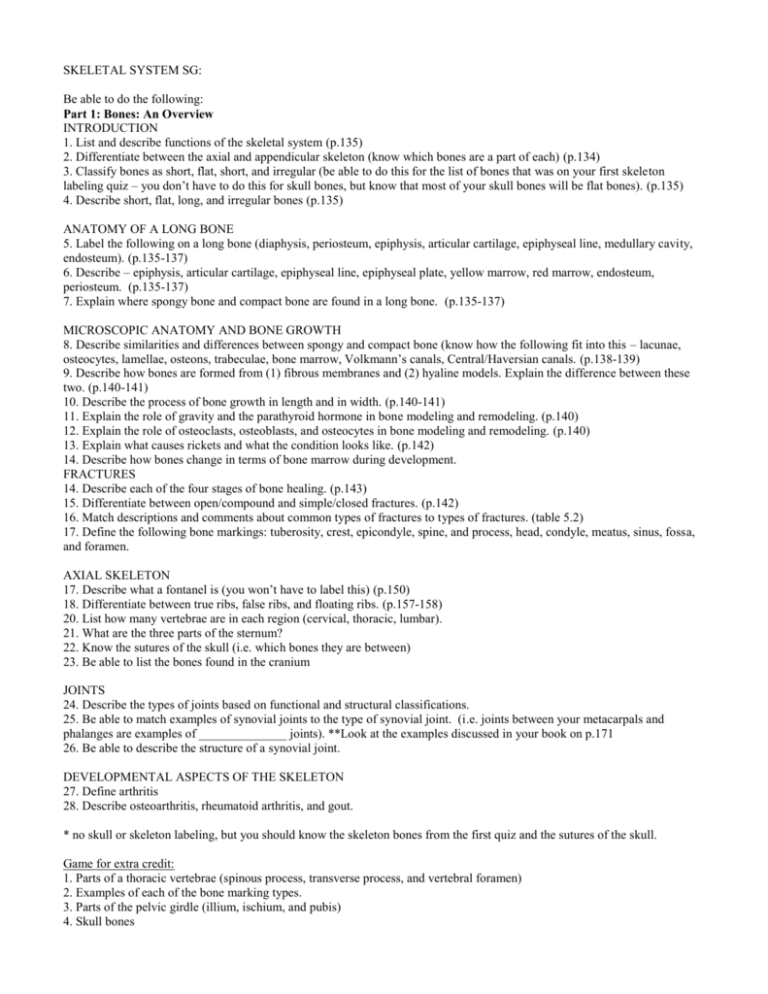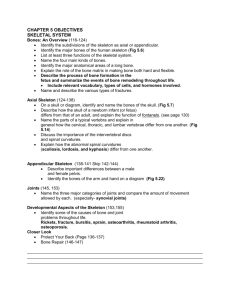Skeletal SG
advertisement

SKELETAL SYSTEM SG: Be able to do the following: Part 1: Bones: An Overview INTRODUCTION 1. List and describe functions of the skeletal system (p.135) 2. Differentiate between the axial and appendicular skeleton (know which bones are a part of each) (p.134) 3. Classify bones as short, flat, short, and irregular (be able to do this for the list of bones that was on your first skeleton labeling quiz – you don’t have to do this for skull bones, but know that most of your skull bones will be flat bones). (p.135) 4. Describe short, flat, long, and irregular bones (p.135) ANATOMY OF A LONG BONE 5. Label the following on a long bone (diaphysis, periosteum, epiphysis, articular cartilage, epiphyseal line, medullary cavity, endosteum). (p.135-137) 6. Describe – epiphysis, articular cartilage, epiphyseal line, epiphyseal plate, yellow marrow, red marrow, endosteum, periosteum. (p.135-137) 7. Explain where spongy bone and compact bone are found in a long bone. (p.135-137) MICROSCOPIC ANATOMY AND BONE GROWTH 8. Describe similarities and differences between spongy and compact bone (know how the following fit into this – lacunae, osteocytes, lamellae, osteons, trabeculae, bone marrow, Volkmann’s canals, Central/Haversian canals. (p.138-139) 9. Describe how bones are formed from (1) fibrous membranes and (2) hyaline models. Explain the difference between these two. (p.140-141) 10. Describe the process of bone growth in length and in width. (p.140-141) 11. Explain the role of gravity and the parathyroid hormone in bone modeling and remodeling. (p.140) 12. Explain the role of osteoclasts, osteoblasts, and osteocytes in bone modeling and remodeling. (p.140) 13. Explain what causes rickets and what the condition looks like. (p.142) 14. Describe how bones change in terms of bone marrow during development. FRACTURES 14. Describe each of the four stages of bone healing. (p.143) 15. Differentiate between open/compound and simple/closed fractures. (p.142) 16. Match descriptions and comments about common types of fractures to types of fractures. (table 5.2) 17. Define the following bone markings: tuberosity, crest, epicondyle, spine, and process, head, condyle, meatus, sinus, fossa, and foramen. AXIAL SKELETON 17. Describe what a fontanel is (you won’t have to label this) (p.150) 18. Differentiate between true ribs, false ribs, and floating ribs. (p.157-158) 20. List how many vertebrae are in each region (cervical, thoracic, lumbar). 21. What are the three parts of the sternum? 22. Know the sutures of the skull (i.e. which bones they are between) 23. Be able to list the bones found in the cranium JOINTS 24. Describe the types of joints based on functional and structural classifications. 25. Be able to match examples of synovial joints to the type of synovial joint. (i.e. joints between your metacarpals and phalanges are examples of ______________ joints). **Look at the examples discussed in your book on p.171 26. Be able to describe the structure of a synovial joint. DEVELOPMENTAL ASPECTS OF THE SKELETON 27. Define arthritis 28. Describe osteoarthritis, rheumatoid arthritis, and gout. * no skull or skeleton labeling, but you should know the skeleton bones from the first quiz and the sutures of the skull. Game for extra credit: 1. Parts of a thoracic vertebrae (spinous process, transverse process, and vertebral foramen) 2. Examples of each of the bone marking types. 3. Parts of the pelvic girdle (illium, ischium, and pubis) 4. Skull bones 5. What a sinus is





